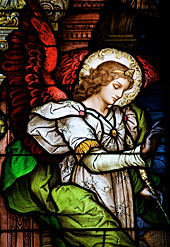What is an Oratorio?

An oratorio is a large musical composition, including an orchestra, a choir, and soloists. Like an opera, an oratorio may also include an ensemble, various distinguishable characters, and arias. However, while opera is musical theatre, an oratorio is strictly a concert performance—although oratorios are sometimes staged as operas, and operas are sometimes presented in concert form.
In an oratorio, there is generally limited interaction between the characters, and minimal or no props or elaborate costumes. A particularly important difference is in the typical subject matter of the text: opera tends to expound on historical and mythological themes, including age-old devices of romance, deception, and murder, whereas the plot of an oratorio often is based on sacred topics, making it appropriate for performance in a church, as well as concert venues.
Historically, Protestant composers derived their stories from the Bible, while Catholic composers also looked to the lives of saints. Oratorios became extremely popular in early 17th century Italy partly because of the success of the opera and the Church's prohibition of spectacles during Lent. Oratorios became the main choice of music during that period for opera audiences.
George Frederic Handel successfully promoted oratorios in England in the mid-18th century, in part, because of the religious objections to opera performances during Lent, but also because they were cost-effective to produce compared to the more elaborate opera productions. His famous Messiah, originally intended to be performed during Lent, was a source of inspiration for The Rosary for World Peace. Charles Jennens, the librettist of the Messiah, included Scripture verses arranged in the traditional Rosary story line regarding the birth, death, and Resurrection of Jesus Christ.
The Sorrowful Mysteries:
The Agony in the Garden
Aria – Mary
O Earth, Earth, Earth,
hear the Word of the Lord.
(Jer 22:29)



